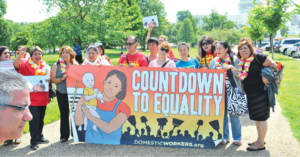 No Harveys here: Sexual harassment is a working class issue. This article is part 2 of a series on workers fighting sexual harassment in the hotels, homes and growing fields.
No Harveys here: Sexual harassment is a working class issue. This article is part 2 of a series on workers fighting sexual harassment in the hotels, homes and growing fields.
The #MeToo campaign has forced Harvey Weinstein and some other sexual predators out of the workplace. But many of these same abusers employ domestic workers at home. How can workers in private home settings protect themselves?
“Linda” is woman is her early 50s who cared for a 67-year-old male client in New Mexico. This client has been inappropriately touching her breasts and lower back and refuses to stop. When she tried to tell her employer — a private agency that contracts out domestic worker services — her manager at the agency began sexually harassing her as well.
Her situation is not unusual. The number one complaint of nannies is over-attentive dads. Sexual abuse is rampant for those who work in someone else’s home. For most, these is little recourse. But Linda turned to the National Domestic Workers Alliance, which filed a complaint with the Equal Employment Opportunity Commission on her behalf.
Organizations such as the National Domestic Workers Alliance and DAMAYAN Migrant Workers Association are fighting for the rights of the 2 million housekeepers, home health aids and nannies. These groups seek to extend legal rights for domestic workers, build grass roots leadership, and raise consciousness about the plight of domestic workers, including theft of wages, trafficking, and sexual and other abuses.
Sexual abuse and assault are crimes in which the offender subjects the victim to sexual touching that is unwanted and offensive. Yet the state turns a blind eye to sexual victimization of women, men and gender non-conforming people. Those most likely to be abused are the socially and economically vulnerable who have few resources with which to fight back.
Homecare workers are largely immigrants and women of color who work alone in their employer’s home. Their vulnerability to abuse is increased by the fact that they are denied legal protections that many other workers have.
Treatment of domestic workers rooted in slavery
Sexual abuse of domestic workers by their employers dates back to the days of slavery. In addition to having no legal freedom or power over their own lives, enslaved women, especially those working in the home, were subject to rape and sexual assault with no legal protection.
During the New Deal era, agricultural and domestic workers were excluded from nearly all of the protections guaranteed by the Fair Labor Standards Act and other federal employment protections extended to most other U.S. workers, including minimum wage, overtime, sick and vacation pay. This was a concession to Southern capitalists, at a time when almost all Black workers were either domestics who worked in their homes or farmworkers who worked their fields.
While some rights have since been won by these workers through hard struggle, agricultural and domestic workers are still not covered by the National Labor Relations Act, are excluded from collective bargaining rights, and continue to be the group of workers with the least legal protections to this day.
As a result, 23.4 percent of in-home workers live below the poverty line, and most work without access to paid sick days, vacation time or healthcare.
Domestic workers “experience abuses ranging from verbal abuse and economic exploitation to physical and sexual assault and forced servitude,” according to a report by a group of NGOs addressed to the UN Human Rights Committee.
‘They worked me till I dropped”
Organizations like Damayan Migrant Workers Association in New York City are crucial to immigrant domestic workers. Damayan is fighting for the rights of Sherile Pahagas and Edith Mendoza, who agreed to travel from the Phillipines to New York City to work in the home of Pit Koehler, a German diplomat, who promised them $10 an hour for a 35 to 40 hour work week.
Instead, they were expected to work 90 hours a week under harsh conditions and paid $4 an hour. Mendoza explained, “I worked six days each week, sometimes for more than 90 hours, and they paid $350.70 per week. The Koehlers worked me until I dropped and then they fired me for calling out sick.”
Pahagas added, “They fooled me into thinking I could come to the U.S. to make good earnings for my family at home but it was all lies. … The Koehlers treated me like a slave.”
Their situation is not unusual. What is unusual is that, with the support of Damayan, these women felt safe enough to speak up. Pahagas and Mendoza are demanding that Koehler pay them their unpaid wages, issue a public apology, and promise never to mistreat his workers again.
Domestic Worker Bills of Rights
Advocate organizations seek to gain domestic workers’ basic rights like minimum wage, vacations, fixed work hours and responsibilities, mandatory time off, and protections from abuse, including sexual harassment, by fighting state-by-state for protective legislation.
It took years of organizing by the National Domestic Workers Alliance and other groups to get the first Domestic Worker Bill of Rights passed in New York state in 2010. Today, that number is up to eight states: Oregon, Illinois, New York, California, Nevada, Connecticut, Massachusetts and Hawaii have each passed a Domestic Worker Bill of Rights. Several of these have protections against sexual harassment.
With 60 affiliates in 30 cities, the NDWA also conducts “know-your-rights” trainings and organizes domestic workers throughout their communities. Mujeres Unidas y Activas, an NDWA affiliate in Oakland, runs a sexual assault hotline for domestic workers to report abuse.
While this this state-by-state effort is crucial and shows important progress, it is piecemeal. A federal domestic worker bill of rights would help ensure that all domestic workers throughout the country are protected, However, most agree that seems unlikely under the Trump administration. Additionally, once laws are passed, there is a struggle to get them enforced.






